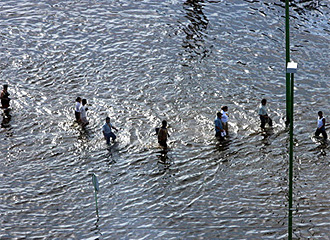 |
 |
 |
 Editorials | Environmental | November 2007 Editorials | Environmental | November 2007  
Crocodiles, Snakes Spark Worry in Flooded Mexico Villages
 Pablo Perez - France 24 Pablo Perez - France 24
go to original


| | People wade through the water along a flooded avenue in Villahermosa, state of Tabasco, Mexico. Crocodiles and snakes taking to flooded streets are posing a new risk in the southern Mexican state of Tabasco, which has been devastated by 10 days of flooding. (AFP/Alfredo Estrella) |
Crocodiles and snakes taking to flooded streets are posing a new risk in the southern Mexican state of Tabasco, which has been devastated by 10 days of flooding.

"Crocodiles are leaving their natural habitats," said Mexican Red Cross coordinator Marta Beatriz Sosa.

She said that the reptiles have started swimming along flooded streets.

Residents wading through the streets slap the water, hoping this will scare off crocodiles and highly venomous snakes endemic to the area.

Authorities also worry about the risk of epidemics in the devastated state.

"There could be dengue, diphtheria, cholera," said Sosa.

President Felipe Calderon announced affected areas would be fumigated to eliminate larvae from the stagnant water.

Authorities have also started removing cattle carcasses that littered the ground in some areas, as slowly receding waters leave behind a powerful stench of putrefaction.

In neighboring Chiapas, rescue teams continued their grim search for victims of a mudslide that buried homes and caused a massive wave as the mud crashed into the Grijalva river.

Authorities said 14 people were still missing after two bodies were retrieved, but residents of the San Juan de Grijalva village put the number of people missing and feared dead at 27.

Several countries including Australia, Canada, Guatemala, Germany, France and the United States have responded to appeals for aid, while Cuba sent a plane with 50 doctors specialized in emergencies.

Experts at the Civil Engineering College of Mexico stressed that beyond emergency aid, Tabasco and Chiapas would need investments of almost 1.9 billion dollars to build infrastructure that would help prevent such disasters in the future. | 
 | |
 |



